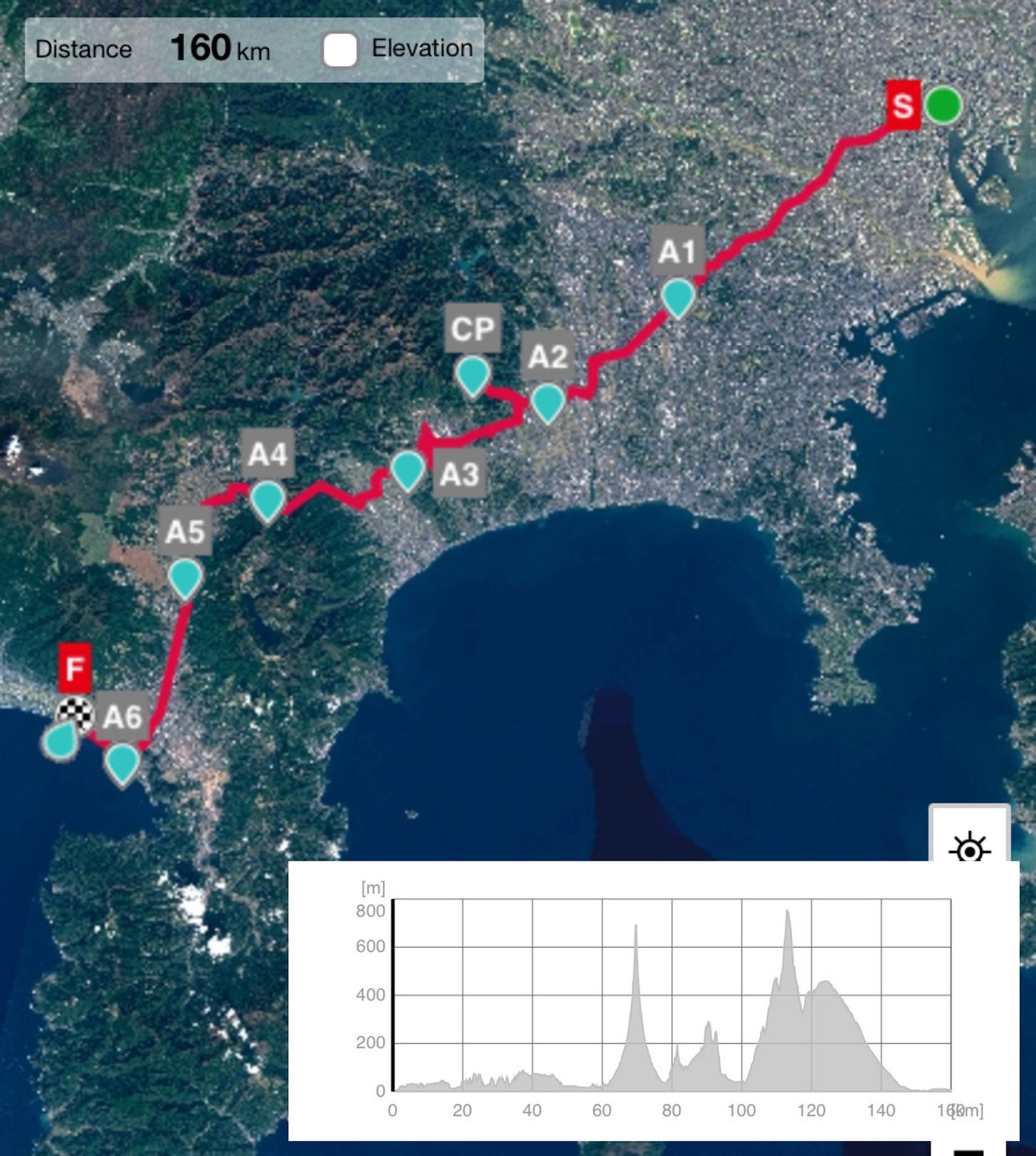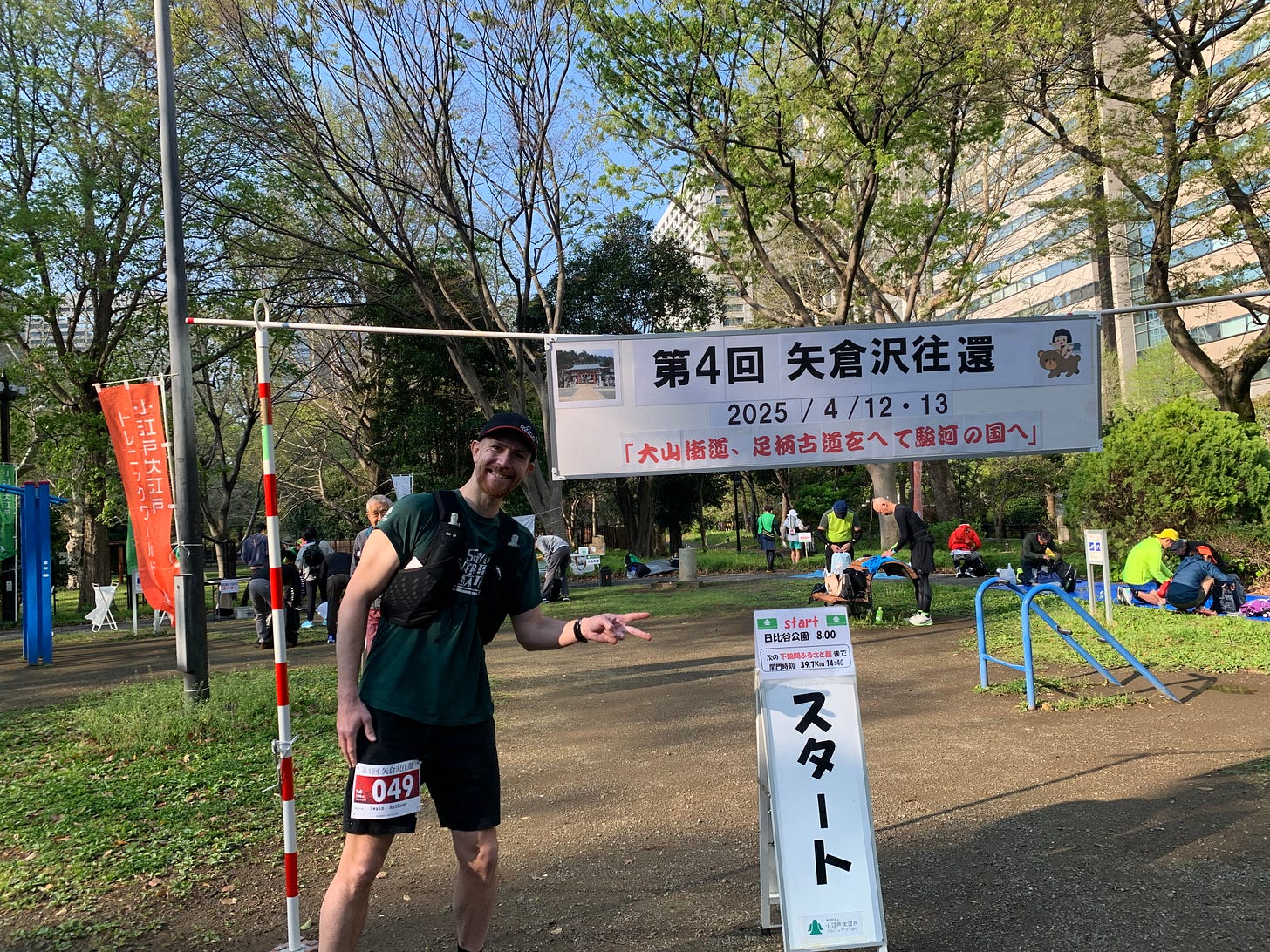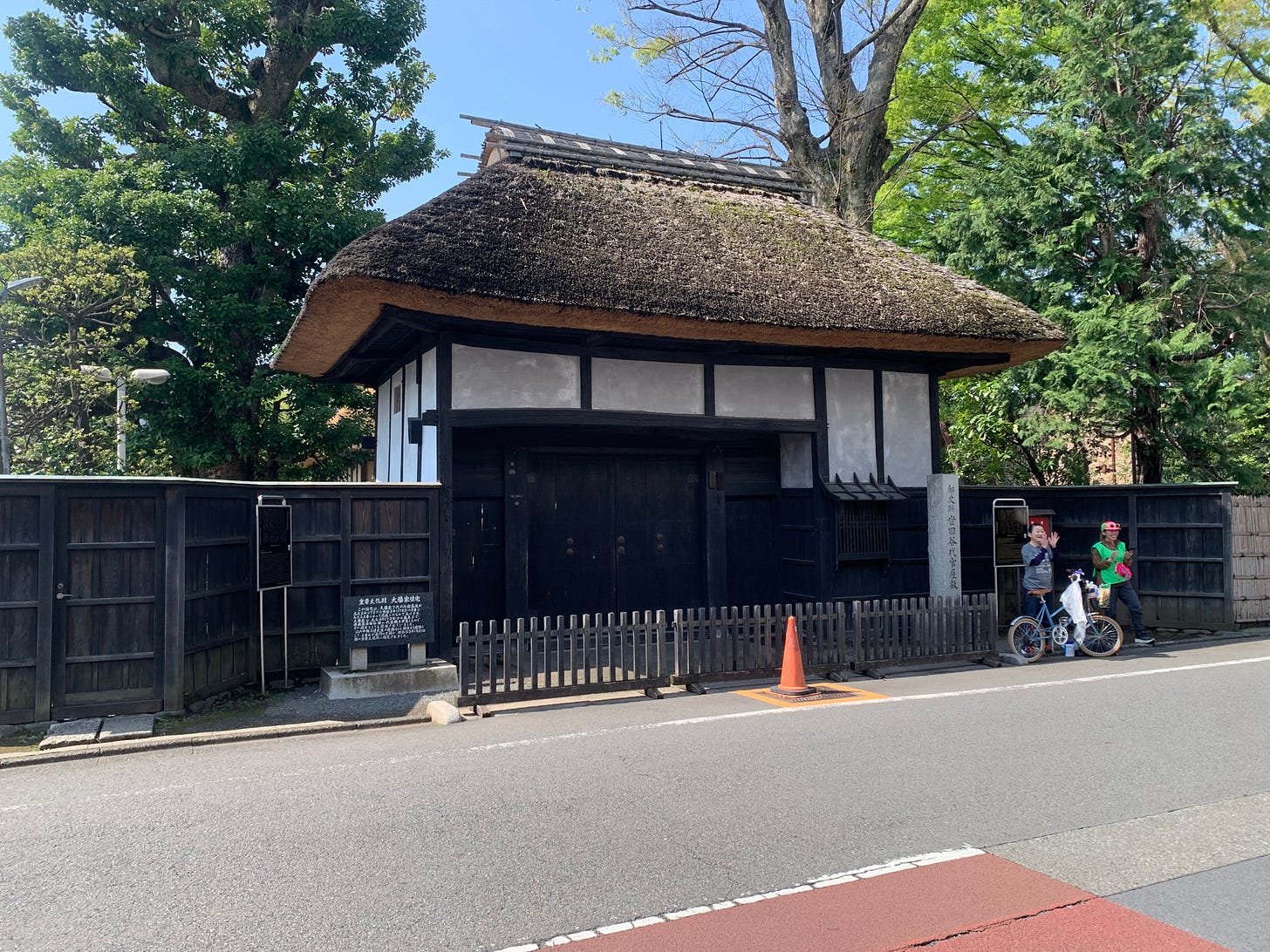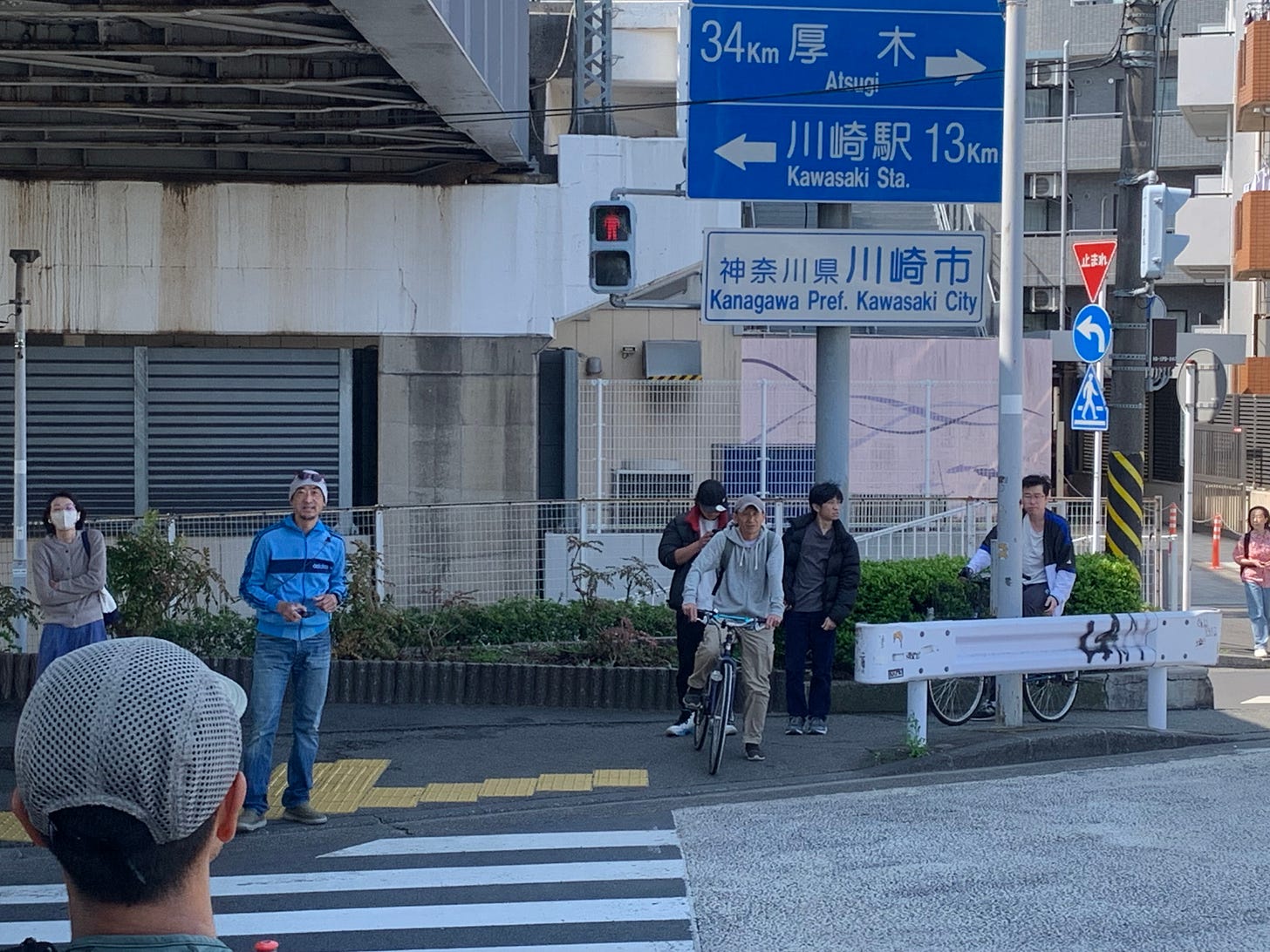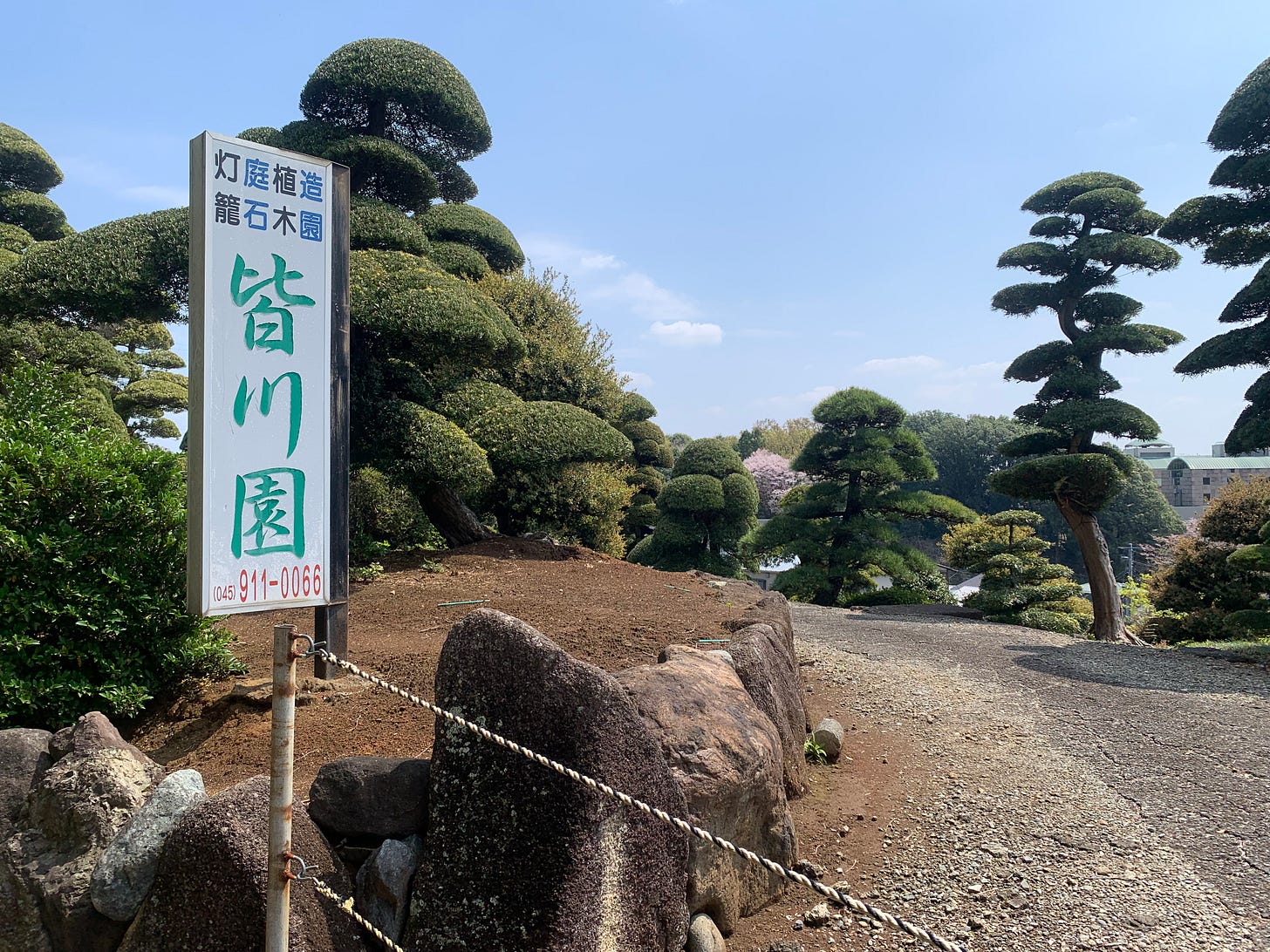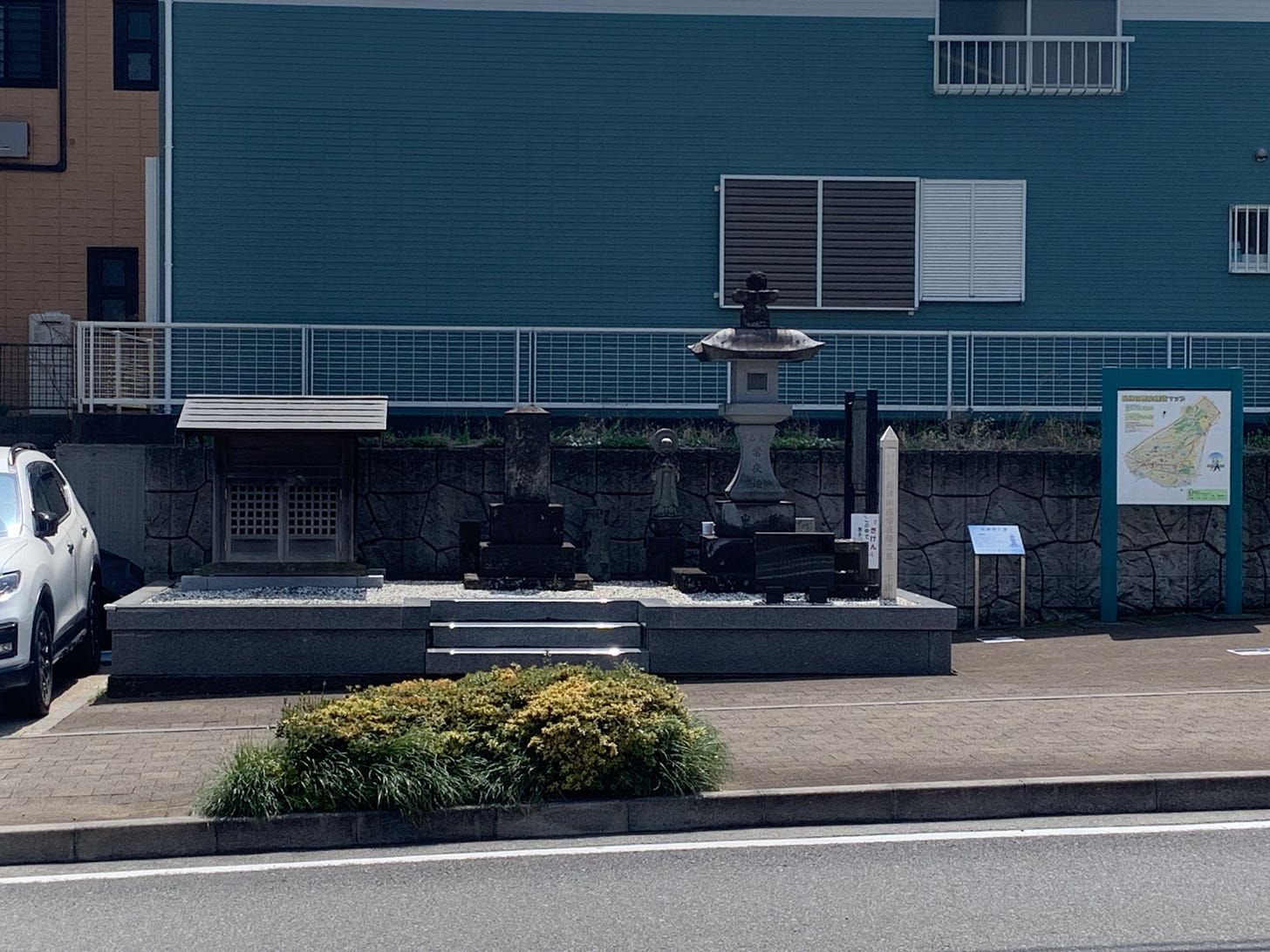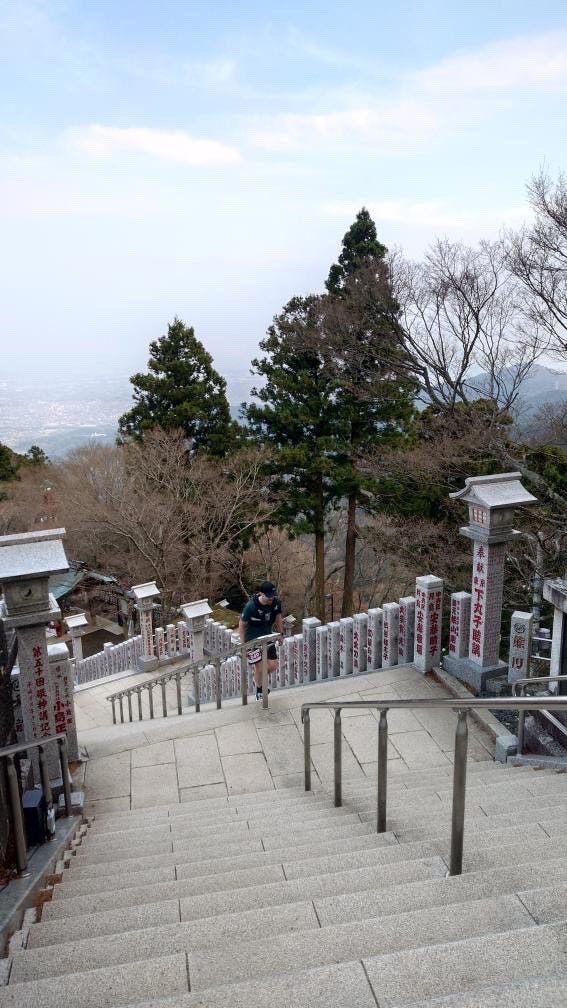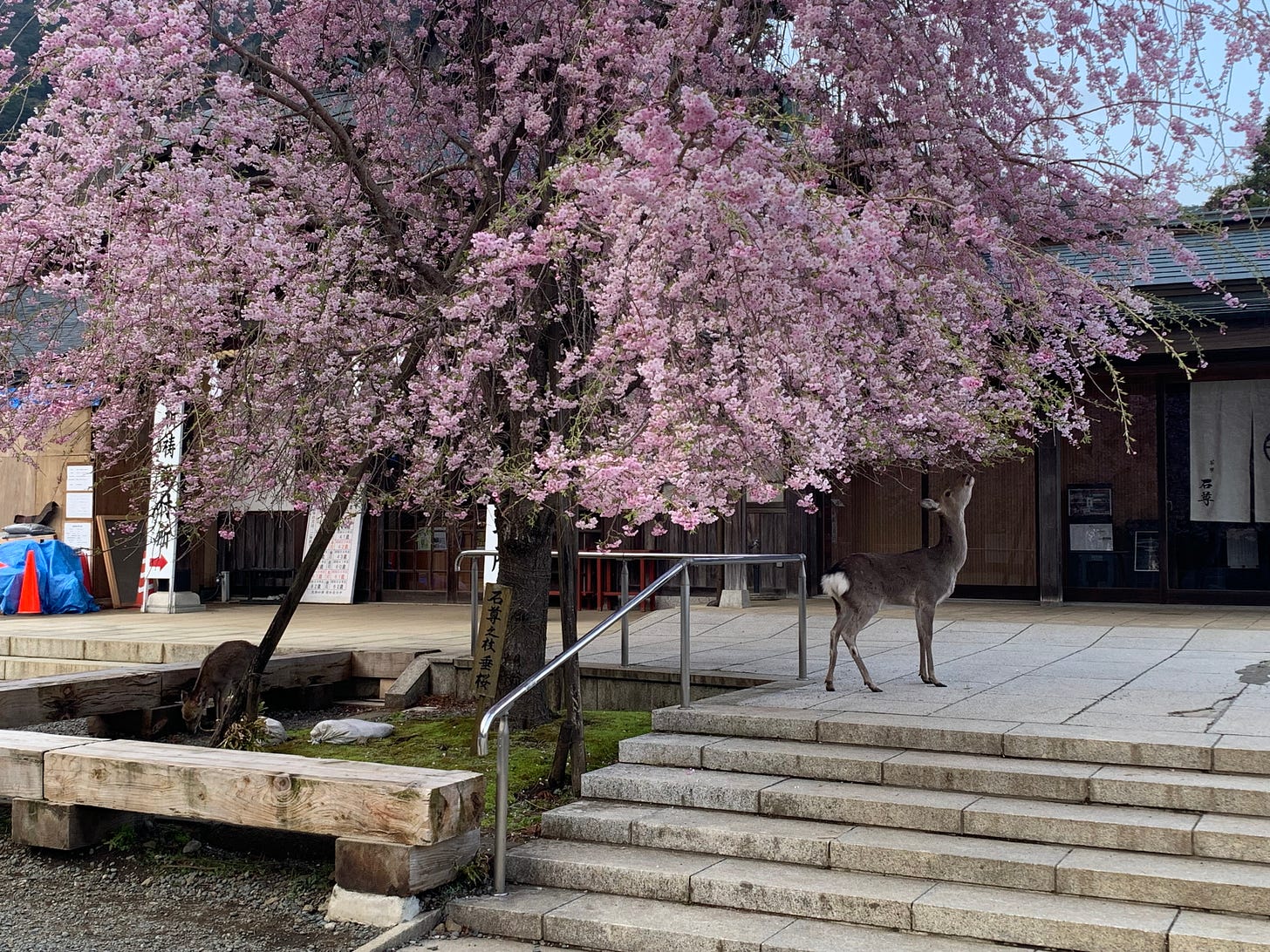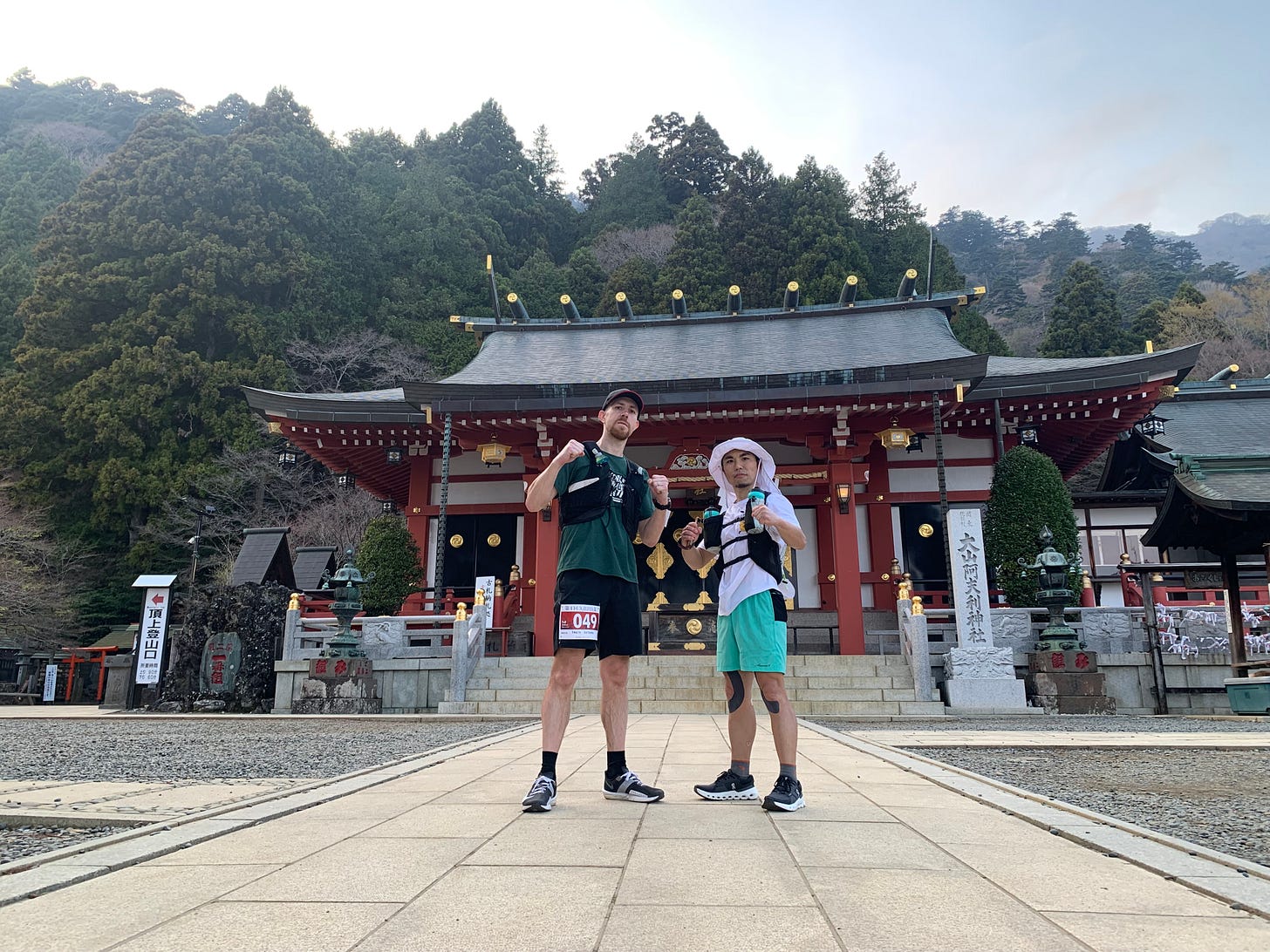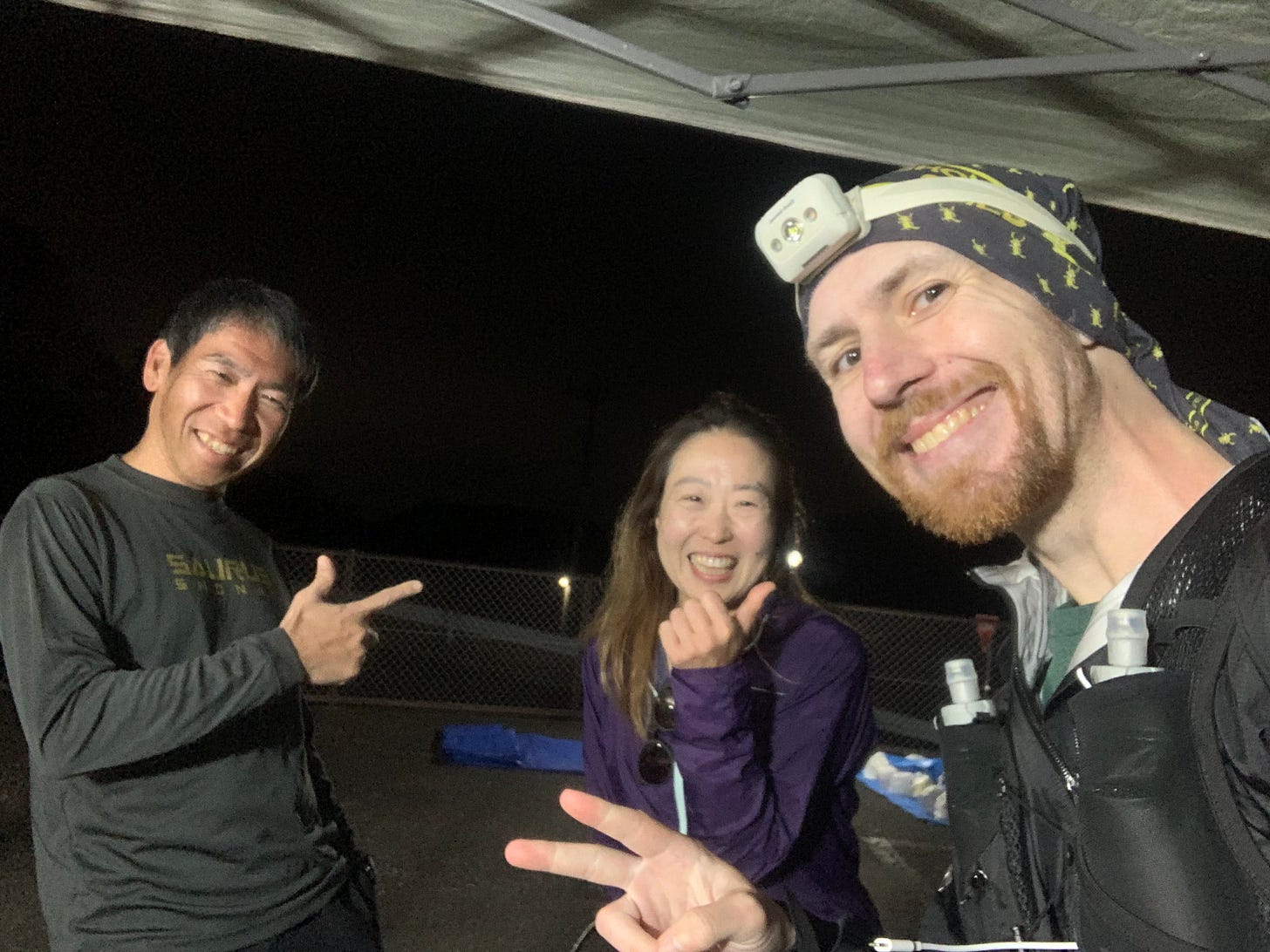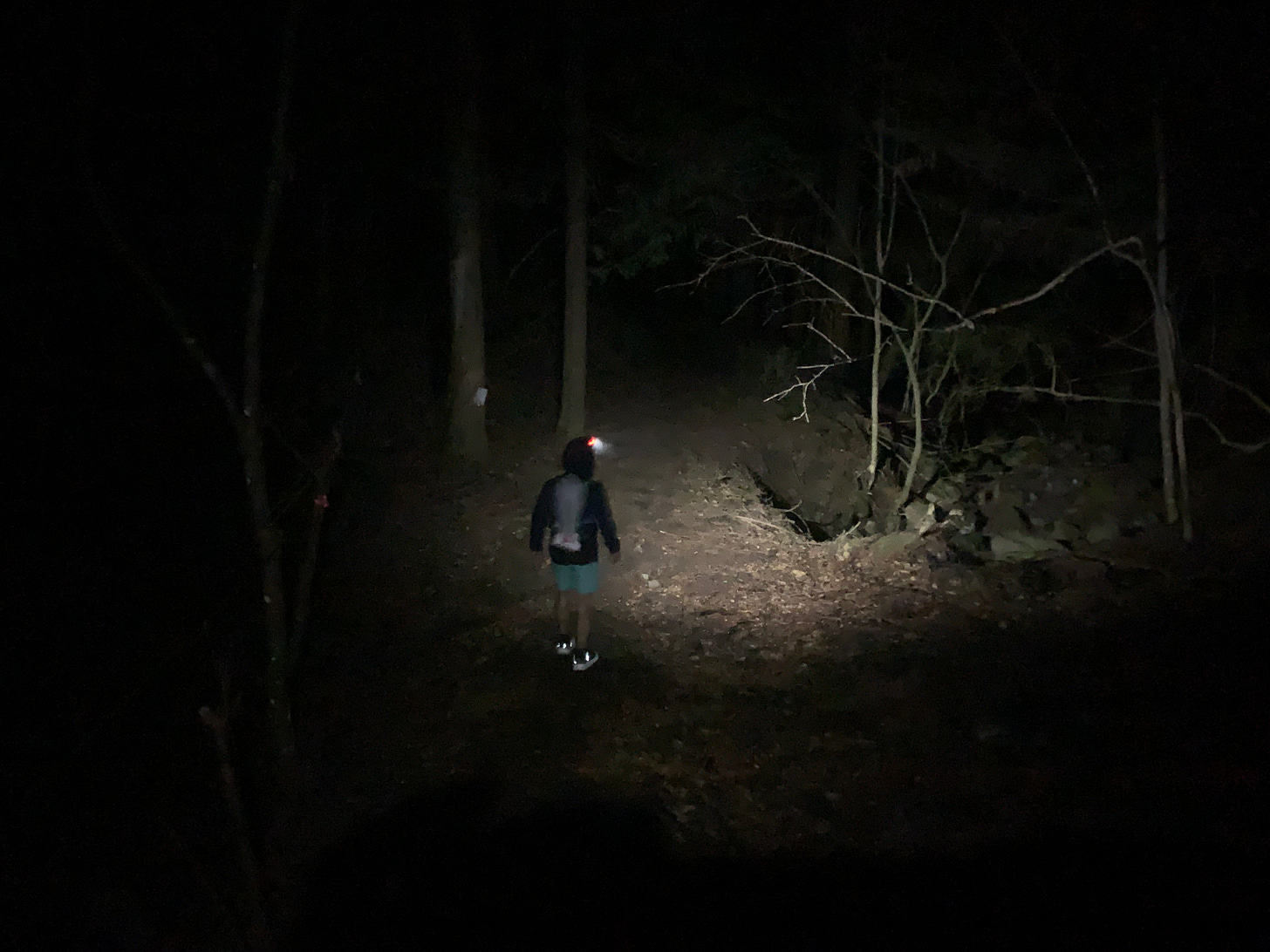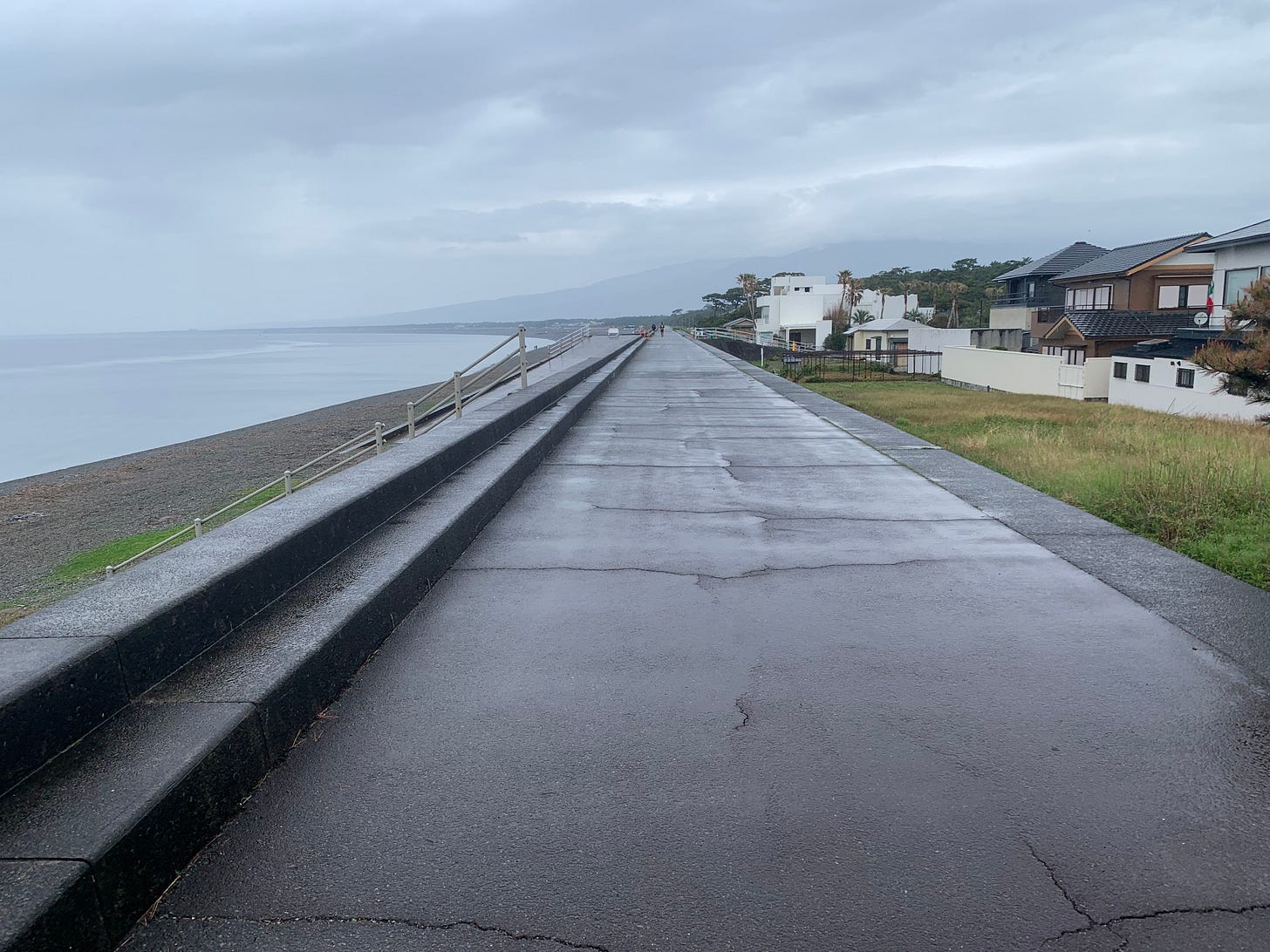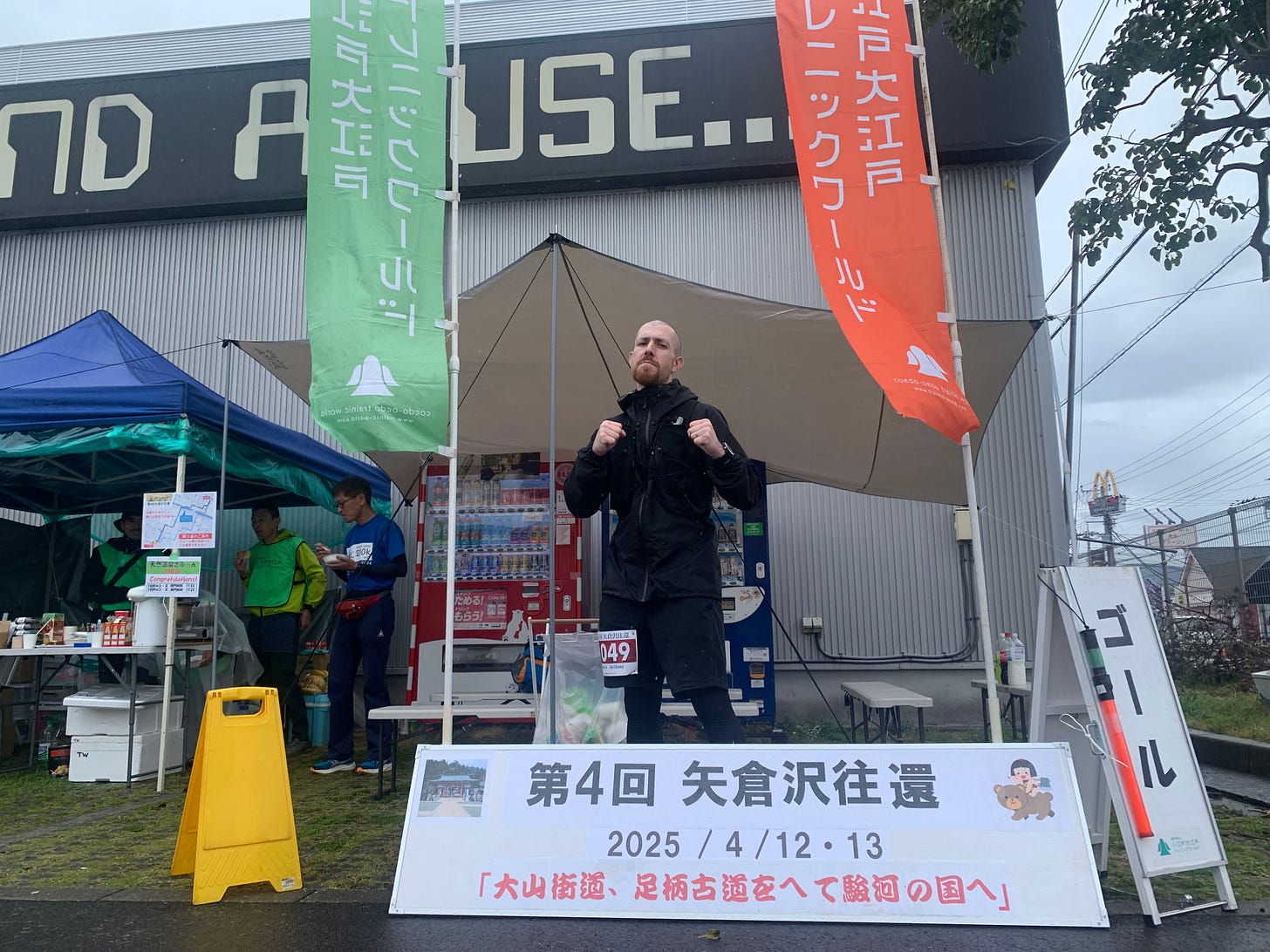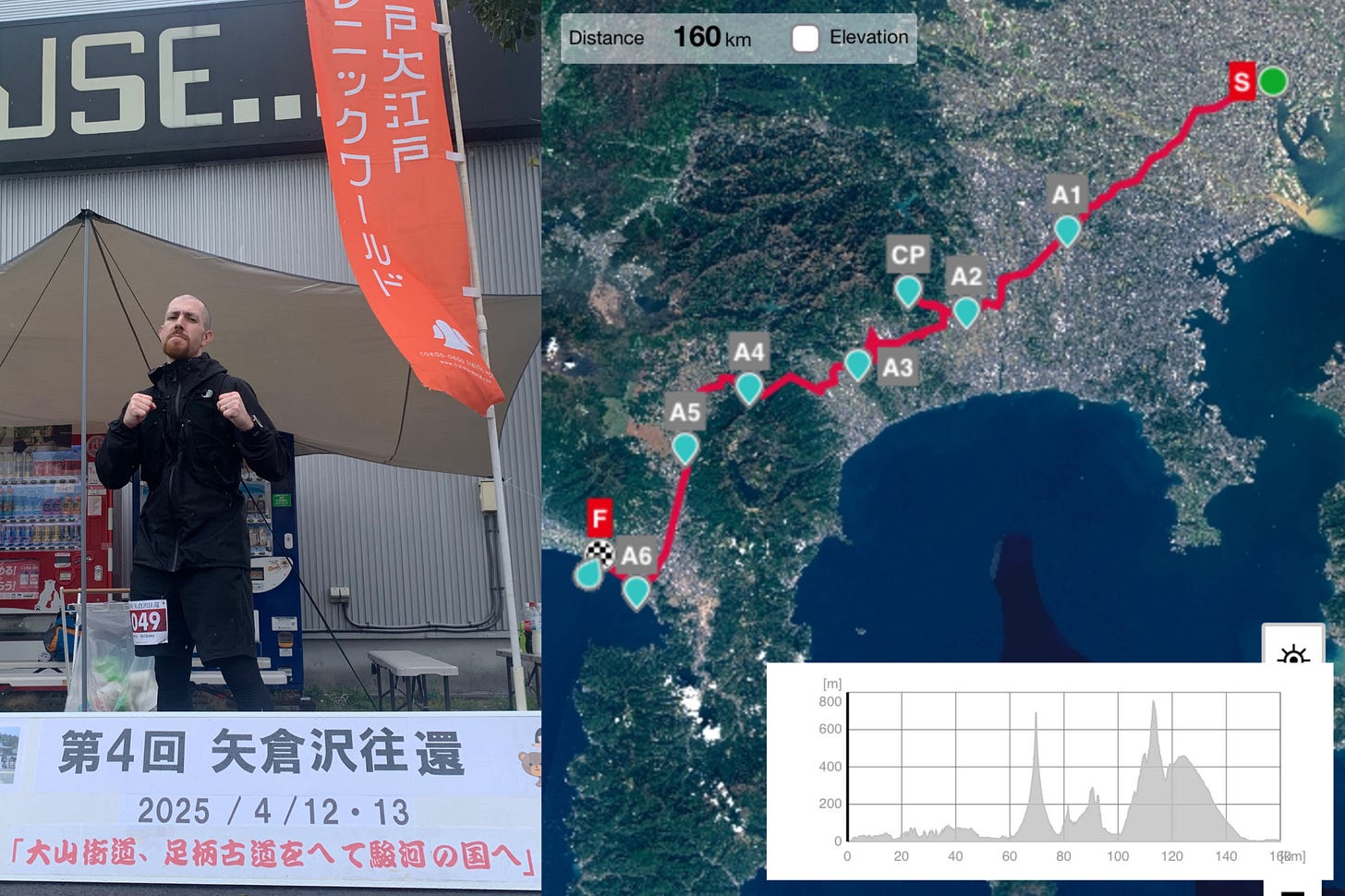Yagurazawa Ōkan (矢倉沢往還): 100 miles
Race Report 17: First 100 miler
Background
This post is a long one so I will spare you a background ramble about this race. I wrote an article titled Exploring the Yagurazawa Highway in the lead up to this one so if you would like to know more about the background of the race please read that one.
The course map indicating the six aid stations (A1-6) and the main checkpoint (CP) at 大山阿夫利神社 (Ōyama Afuri Shrine) is shown below along with the elevation plot. The course had a combined elevation of 2,598 meters (8523 feet). The run started at 日比谷公園 (Hibiya Park) in Tokyo and ended at 天然温泉ざぶ~ん (Natural Hot Spring Zabu~n) in 沼津 (Numazu), Shizuoka.
第4回矢倉沢往還 (The 4th Yagurazawa Highway) - 12 and 13 April, 2025
The run started at 08:00 from 日比谷公園 (Hibiya Park) in Tokyo. This is right next to the imperial palace. I woke up at 5am and took the train over to Tokyo to arrive just after 7am. I slept reasonably well and thought a good nights sleep at home would serve me better than trying to sleep in an uncomfortable hotel closer to the event.
I arrived in the park, dropped off my luggage and drop bag, and picked up the gear required for the race, including an IBUKI GPS tracker which was attached to my backpack. The position of all of the runners were accurately tracked by these IBUKI GPS devices so the staff and other people watching the race were able to keep an eye on where everyone was.
There was an opening ceremony just before we set off. The race organizer told everyone quite bluntly, 「完走ないとダメです」(Kansō shinai to dame desu: “It’s unacceptable not to finish”), and held up a bag of cookies/snacks that we would get if we finish the race. We then took a quick group picture (unavailable at the moment) and set off at 8:00.
The run through Tokyo
Right off the bat I had a problem with my watch. I was having problems starting it on the correct setting, and it seemed like I had it on a bike ride rather than a run. I quickly realized the error, stopped my watch, then started it again as a run. Some loss, but I realized it early and probably only missed the first 500 meters of the run (not that it mattered anyway as it turned out later).
I didn’t want to set out too fast but I ended up in the front pack of runners for the first section of the race. One guy set off really quickly (I believe he won in the end), but I was with a few guys where we were at joint 2nd, 3rd, and 4th place for quite a long while. We were chatting as we were running along so it wasn’t too strenuous, but I did notice that we were running a bit quicker than it was sensible for ME to run on my first 100 miler.
We ran past the Diet building and through some of the busier areas of Tokyo including 渋谷 (Shibuya) and 世田谷 (Setagaya). There were a lot of people to dodge around and it was generally not a great place to run.
There were checkpoints that we needed to go by as we ran along but there was no specific procedure for checking in at those points. It was literally just that the IBUKI system needed to show that we ran by them so there was no need for us to even look at those checkpoints. Where possible I took pictures as I went along but at that point I was trying to keep up with the guys I was running with. (It was noted that because the course is totally unmarked that we might get lost here and there. We were told that it’s fine as long as we make our way back to the main course as best as we could).
I ended up running by the second check point without even seeing it (though according to the results I did run by it), and my pace started naturally adjusting to something a bit more reasonable around 二子玉川駅 (Futako-tamagawa Station). As I was running by the station some people recognized my hat and started calling out, “Hi parkrunner!” I turned around and yelled back that I was running to Shizuoka, at which point another runner (S-San) started a conversation with me as we ran along. (S-San had never heard of parkrun before so I filled him in on the details).
Both S-San and I left Tokyo together and headed towards the first checkpoint. We got lost several times along the way (as mentioned, there were literally no course markers) but we managed to figure it out using different GPS devices.
As we got further and further out of the Tokyo area the streets started getting a lot less crowded with people but more populated with cars. It was also quite hot and at one point I dropped into a convenience store for a cold bottle of sports drink, which I downed in one go.
We kept running and went by a small aid station set up by locals, where I happily accepted a cup of coke and a strawberry. Then it was on to the first actual aid station of the course.
I entered the first aid station at 下鶴間ふるさと館 Shimotsuruma Furusatokan (39.7 km) to find a friend of mine waiting for me (R-San). My friend had been cycling around checking out the course on the days leading up to the ultra and wanted to show his support on the way. I entered the aid station had a chat with my friend and the volunteers and resupplied. I had two soft water bottles with me and I had some powdered sports drink, so I refilled my bottles with my concoction before loading up on calories. I ate a rice ball, a few pieces of bread, and a banana before setting off again down the highway.
At this point I was getting a bit deeper into the countryside but there were still a lot of cars on the road. My friend, R-San caught up with me here and there on his bike to give me some encouragement as we went along (he also told me he was going to cycle ahead and enjoy some food at a Brazilian restaurant he found the other day). I kept moving forward, got lost a little bit, but then eventually got myself reoriented and on the right track again.
I ended up running along an area that I recognized, and realized I was in 座間 (Zama). There is a Costco in Zama and I was thinking to myself that it would be nice if someone set up a makeshift aid station with some Costco pizza. Just as I was thinking about the pizza another runner (G-San) caught up to me. We started talking and it turned out we had similar goals and experience (this was also his first 100 miler) so we decided to stick together for the time being.
We kept running along together and kept chatting, and we also make sure to occasionally check our pace so we didn’t completely burn ourselves out running up the hills (since we knew there were mountains coming up). We started using a system where we would do combination run/walks up the hills and run all of the downhill segments.
We crossed a few bridges and eventually came to a check point at 厚木の渡しAtsugi no Watashi (51.7km). The check point was not in a place I would call logical because we needed to go out of our way to find this old crossing point that was nowhere near the modern bridge. Then we turned a corner and started backtracking to head towards the next aid station.
It was just under 10 km to the next aid station but as we were running it was starting to get darker. Not due to the time of day but due to some angry looking clouds that were appearing over the mountains we were heading towards. G-San kept pointing at the clouds and (jokingly) saying that they were my fault. We kept pushing along until we hit the 60 km point, at which point I blurted out, “YES! 100 KILOMETERS…to go.” Your mind makes some weird milestones when you are doing something like this.
We turned up at the next aid station where my friend R-San was waiting along with the race director. While refueling (eating udon, pudding, bananas, salt tablets, sports drink), I had a chat with the race director. He warned me not to go out too quick and to make sure that I could finish the race…or else.
We left the aid station in good spirts and after a bit of running on some undulating terrain things started getting to the point where it was just going to be straight uphill for the next 7km or so. The plan at this point was to power hike up to 大山阿夫利神社 (Ōyama Afuri Shrine) and then get off the trail before it got dark.
I’ve been to Afuri Shrine many times and I know how steep the hill is. The scenery is stunning but the hills themselves are not very kind to people trudging up them. Before the trail segment there is a set of stairs with rows of shops and restaurants along it. The flat sections of these were quite kind but we knew as soon as we got to the cable car station things were going to get a bit rough. (It also didn’t help that some of the steps had stuff like “almost there” written on them, despite the fact we knew that we were NOT almost there).
I met my friend R-San at the top of the stairs just before the cable car station/trail head. He needed to go home because it would be dark by the time he got home if he didn’t set off then and there. We said our goodbyes and G-San and I headed to the trail.
We ended up taking a slightly wrong turn and decided it probably wasn’t correct for us to need to use our hands this much to climb so we doubled back and went the other way, past 大山寺 (Ōyama Dera (temple)) and then up some of the most brutally steep trails I’ve ever been on to Ōyama Afuri Shrine (69.7km).
When I got to the top of the stairs there were almost no people at the shrine. There were few race volunteers, and that was about it. The views were absolutely stunning and there was a baby deer and its mother under a cherry blossom tree right next to the shrine. I snapped a few pictures, refueled a bit, put my headlight on (it was still light but we had about an hour or so of sunlight left) and then set off.
It was almost impossible for me to get any sort of rhythm going when descending the stairs. The trail was simply too steep and uneven for that to even be a consideration. G-San is a much better trail runner than I am so he just flew down the hills without much trouble, but I had to carefully descend up until Ōyama Dera before I was able to start finding a rhythm again.
By the time we got back down to the shops and restaurants I was able to full on run again. I find going downhill on roads to simply be a case of picking up my feet and letting gravity do the rest. Both me and G-San sped down the hill past all the scenery we enjoyed on the way up, but we also went by a lot of runners that were heading up to Afuri Shrine with their headlights on. We had achieved what we said we were going to do by getting off the trail by nightfall but we still had a lot of ground to cover before the next aid station at 92.5 km.
All the running downhill had elevated my body temperature so I took a quick break at a convenience store to down a bottle of sports drink. More than 30 km between aid stations at this point was quite a distance so I wanted to make sure I didn’t run out of water as I was running. This turned out to be a good move.
As we ran towards the next aid station we started being taken off the main road and through some incredibly dark trails to the side of the main road. There were signs out there telling us to watch out for bears and there was very little in the way of an actual road to follow. We could more or less figure out where we needed to go based on the shape of the trail and the general direction but this was the first night section of the trail for us so I was still getting used to this.
Switching between trails and roads happened quite often around here. We passed some interesting looking hotels, ran through some tunnels, and then started hitting civilization again as we approached 秦野市 (Hadano City). While running through Hadano there was a family (mother, father, and daughter) who were on a bridge and started clapping as we approached. The little girl gave us a piece of chocolate and a salt tablet as we went by, so it was obvious that they’d prepared to meet runners at this point. It is always wonderful to run into locals that support these kinds of events.
We were still quite a way out from the next checkpoint and after leaving Hadano we started heading into gradually more countryside areas again. The next aid station was on top of a hill so we just kept on jogging/trudging through these confusing country roads, up hills, and though very dark farmland.
While running through the darkness we started to see animals here and there. A big civet ran between us at one point (G-San thought it was a cat), and at one point we got a bit lost at a fork in the road, but I noticed a frog hopping in one of the directions. We ended up following the frog, which turned out to be correct (thank you frog). Also, while we were running through the next dark area we thought we may have missed the next aid station. We received a message that some runners had come across some dogs in the dark and needed to take a detour around them, but we had not run into any of those. After remaining lost for a bit longer (and having totally run out of water), we eventually came across the aid station at 富士見塚 Fujimizuka mound (92.5 km).
This aid station was an important one because it was here that we were able to access our drop bags. We ended up staying at this aid station for a good 20 minutes. I ate, drank, fully resupplied (making new sports drink), and changed my entire outfit. I knew it was going to start getting cold during the night so I prepared a some long sleeved thermal wear, and some leggings to keep warm, along with my raincoat. (Fresh underwear and socks were also a blessing at this point. Don’t neglect these on very long runs).
While I was eating at the aid station heard someone calling after me. Some of my friends had been tracking me on the IBUKI system and had driven over to the aid station to say hi. It was amazing to see some familiar faces from out of the darkness. I was almost 100 km into this run but felt ready to tackle the rest of the run knowing I had so many people cheering me on.
G-San and I eventually left the aid station. We ran downhill for a while, past some orange trees (which would have looked tempting had we not just been at an aid station), and then kept on running through more of the same up and down combination of trails and countryside roads.
After running like this for about 10 km we came across an extra aid station at the beginning of the old road/trail that headed towards the Ashigara Pass. The people running the aid station were friends of G-San, and were incredibly enthusiastic about helping the runners. They had a tent, a snack table, and an entire table covered in energy drinks and coffee for the runners. The guy running the aid station said he was “in the red” from buying all the stuff but would be out here all night to support everyone no matter what. These people were absolute heroes.
After we left the aid station we were told to go up this old road, which had definitely seen better days. Old bamboo had fallen across the road in a lot of areas so it took a lot of going over and under natural obstacles to get through the place. Guchi San and I eventually started talking about ghosts since this was one of the most cursed places I’d ever seen, but we (largely) managed to get through without seeing anything.
I was expecting to start hallucinating at some point during the run and as we got deeper into the mountains I started seeing some things that I knew weren’t actually there. I saw a tree covered in hands, faces in rocks, some glowing eyes looking at us from out of the darkness, and a few times I saw 不動明王 (Fudō myōō: The Immovable Lord) in trees (who would disappear when I got close enough but would reappear when I looked back).
We kept climbing up roads towards the 足柄峠 (Ashigara Pass) and the main course kept having us go up trails to cut off the corners. The problem was that it was incredibly foggy so we missed the trail entrance several times and kept having to go around the looping roads until we came across the next trail. It wasn’t ideal to be running on these roads late at night because there was the occasional reckless driver that was drifting around the mountain curves in a noisy sports car. Those guys were definitely not expecting to see runners hiking up the road in the middle of the night.
As much as possible we kept to the trail (getting lost and ending up in a graveyard at one point), but we eventually got to the Ashigara Pass aid station at 113.0 km. It was very cold and it wasn’t a good idea to stay still for too long. I ate some stew to warm up a bit, resupplied my drinks, then got ready to start the main descending part of the course.
After leaving the aid station we went downhill to literally the only part of the course that had a marker on it. There was a flashing arrow that just pointed to a ridiculously dark trail that thankfully had the occasional guide rope on it so we didn’t end up completely lost in the woods all night. I realized at this point that I hadn’t taken too many pictures so I asked G-San to stop and point his light away from me so I could take a picture and show just how dark it was. The fog was coming and going, but the trees somewhat shielded us from the rain a bit in the forest.
The trail itself was a bit rough under foot. I was a little concerned about rolling my ankle, but it was relatively ok. I didn’t actually fall at any point and the trail didn’t have any incredibly steep descents, so we managed to get through this section without any major issues.
After we exited the trail section we were back to the roads. I ended up missing the trails after a while because of the different muscles used when running on trails. Roads have a tendency to punish the same muscles over and over again without giving you a break. It was getting difficult for me to raise my legs and G-San was suffering a bit with his ankles. We agreed that at the next aid station we might have to separate due to how we were handling the race differently. I was able to power walk quite quickly despite myself. but G-San was more the type of person to do bursts of jogging then walking.
It was about 04:30 when we reached the next aid station at 富士岡公園 Fujioka Park (130.2 km). I drank some soup, ate what I could, and drank as much sports drink as I could before moving on. The volunteer at the aid station described the next part as the “last spurt” of the course, but I was a little skeptical considering there was still about 30 km left.
I left the aid station and unfortunately lost G-San quite quickly. We were both fighting battles with every step. I was moving with my center and determined to just keep going one step after the other until I got to the end of the course. But other things started falling apart at this point too.
My watch battery totally died somewhere in 御殿場 (Gotemba) and I didn’t have a way to charge it. It was largely a straight line for most of the last section of the course so I tried to follow where I was on the IBUKI system using my phone. Because I didn’t have real time updates I got lost a few times and needed to redirect, but I just kept going step by step towards the finish.
It got light and but it didn’t really do much for my mood. The rain was pouring down and I was worried about my phone running out of batteries. I took a few turns around the city in 沼津 (Numazu) and eventually found myself crossing some bridges and heading towards the final aid station.
I was debating whether I should stop at the 港口公園 (Minatoguchi Park) aid station at 152.0 km since it was only 8 km from the finish line. When I arrived I was glad that I did. I got there at around 08:45 and I was barely able to speak. The volunteers were talking to me but I realized I was really slurring my words when answering them. I drank some tofu soup (which I wasn’t sure if I’d enjoy, but it turned out to be one of the best things I’ve ever consumed), and a cup of coffee, and then I was ready to go.
The very last section of the course was probably the most frustrating parts. There was a very long stretch along the coast, which just seemed to go on forever. Every time I checked the IBUKI system it seemed like I hadn’t made any progress at all. I convinced myself that it was ridiculous to have not made ANY progress and just kept repeating to myself to keep going one step at a time until I go to the end.
A couple of runners overtook me, which gave me a bit of hope because it showed I was going in the right direction. I took a right, went through a pine forest, started cursing at a “no entry” sign that seemed to be on the route, went around it, then found myself in a kind of residential area leading up to the finish line.
I had to go over a road bridge before I could actually see the finish and was still a bit confused when I got to the bottom of it. I eventually noticed some staff waving at me and knew I was just about there.
I moved as quickly as I could towards the finish line. It probably wasn’t pretty, but it felt pretty glorious at the time. I was congratulated by the staff, they stopped the GPS Ibuki device, then shuffled me over to a bench and handed me a finisher certificate, a bag of snacks, and a hot spring ticket. Before I did anything else I took a picture at the finish line, then ate a bowl of curry before limping over to get my gear and have a bath.
After the race
Immediately after the race as I was taking my shoes off (very slowly) at the hot spring, G-San came over to me. It turns out he unfortunately needed to drop out of the race shortly after the Fujioka Park aid station. This was his first attempt at a 100 miler so he told me he would train up and give this one ago again in a couple of years. It was a shame that he was unable to finish but he still got a personal best for distance. In great attempts, even failure is glorious.
I almost passed out about 6 times in the hot spring but it was very good for recovery. The hot spring, not the passing out. I managed to drop myself into a taxi then take a train home after all was said and done. I took a nap when I got home, went to bed very early that night, and then slept like a log.
The following day I somehow managed to get 10,000 steps in (though my right leg still wasn’t in good condition), and I managed to run my first mile on the second day after the race. Recovery for this one was much quicker than the first time I did a big ultramarathon, so I must be starting to get used to this kind of thing.
Results
I finished the ultra in 26:23:12. I came in 14th overall. Of the 94 people who entered the 100 mile event, 12 did not start, and 21 did not finish. 61 people completed the run leaving a completion rate of 74.4%.
Final thoughts
This event was an experience. I feel a great sense of achievement from having completed a 100 mile ultramarathon, but I wouldn’t say that it was fun from start to end.
When I ran the Challenge Fuji 5 Lakes Ultramarathon there were a lot of people to run with and there were a lot of aid stations. Looking back on it, it seemed like a party atmosphere the entire way around. This one was quite a lonely ordeal where we saw very few people along the way.
Every time I ran into an aid station in this course I really appreciated it. It was almost 40 kilometers to the first aid station, so reaching each one felt like a massive reward.
This was my first time hallucinating during a run. It wasn’t as freaky as I thought it would be, but I can 100% understand from it how people have visions and religious experiences while putting their boy through quite extreme hardship.
I like to challenge myself and this was definitely one of the bigger challenges I’ve done in my life. It was hard, but it didn’t feel as tough as the first time I broke 100 km. Once your body has started to adapt to this kind of thing it gets a bit easier each time. The first time I ever ran a marathon I could barely walk for a week. I was very similar after my first 100K run. But now, a marathon can simply be something to run between aid stations.
Overall, I’m really glad that I did this. This was an absolutely unforgettable experience. I learned a lot about myself and feel like I have massively improved both physically and mentally.
While my next challenge might not be a 100 miler, I’m very much looking forward to overcoming the next big challenge in my life.
Thank you!
If you made it this far, thank you very much for reading. Reliving this experience as an after action report was a great way for me to let the whole experience sink in.
If you enjoyed my writing please consider subscribing for more content like this.
Cover picture:


